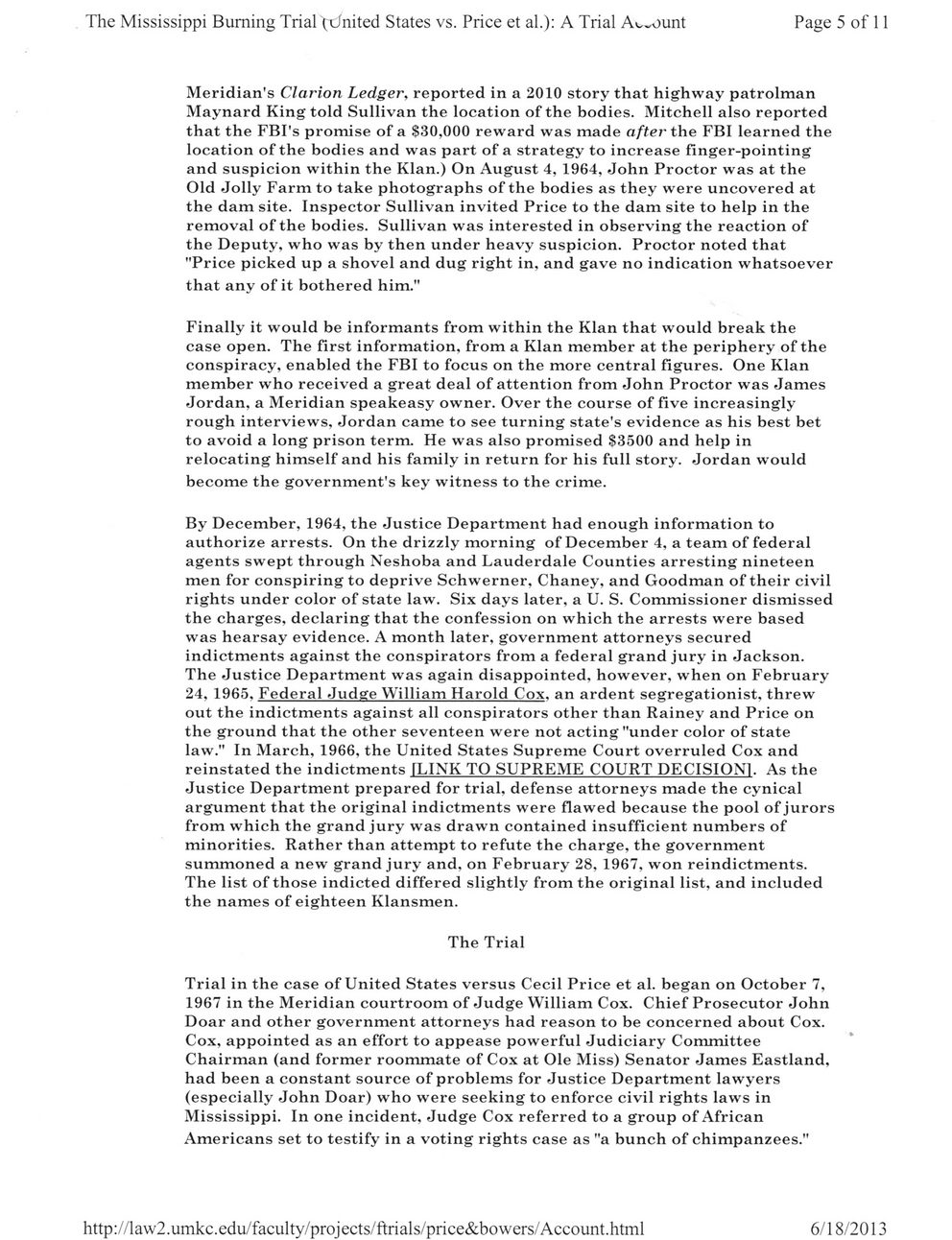This text was obtained via automated optical character recognition.
It has not been edited and may therefore contain several errors.
The Mississippi Burning Trial \ Jnited States vs. Price et al.): A Trial Amount Page 5 of 11 Meridian's Clarion Ledger, reported in a 2010 story that highway patrolman Maynard King told Sullivan the location of the bodies. Mitchell also reported that the FBI's promise of a $30,000 reward was made after the FBI learned the location of the bodies and was part of a strategy to increase finger-pointing and suspicion within the Klan.) On August 4, 1964, John Proctor was at the Old Jolly Farm to take photographs of the bodies as they were uncovered at the dam site. Inspector Sullivan invited Price to the dam site to help in the removal of the bodies. Sullivan was interested in observing the reaction of the Deputy, who was by then under heavy suspicion. Proctor noted that "Price picked up a shovel and dug right in, and gave no indication whatsoever that any of it bothered him." Finally it would be informants from within the Klan that would break the case open. The first information, from a Klan member at the periphery of the conspiracy, enabled the FBI to focus on the more central figures. One Klan member who received a great deal of attention from John Proctor was James Jordan, a Meridian speakeasy owner. Over the course of five increasingly rough interviews, Jordan came to see turning state's evidence as his best bet to avoid a long prison term. He was also promised $3500 and help in relocating himself and his family in return for his full story. Jordan would become the government's key witness to the crime. By December, 1964, the Justice Department had enough information to authorize arrests. On the drizzly morning of December 4, a team of federal agents swept through Neshoba and Lauderdale Counties arresting nineteen men for conspiring to deprive Schwerner, Chaney, and Goodman of their civil rights under color of state law. Six days later, a U. S. Commissioner dismissed the charges, declaring that the confession on which the arrests were based was hearsay evidence. A month later, government attorneys secured indictments against the conspirators from a federal grand jury in Jackson. The Justice Department was again disappointed, however, when on February 24, 1965. Federal Judge William Harold Cox, an ardent segregationist, threw out the indictments against all conspirators other than Rainey and Price on the ground that the other seventeen were not acting "under color of state law." In March, 1966, the United States Supreme Court overruled Cox and reinstated the indictments fLINK TO SUPREME COURT DECISION!. As the Justice Department prepared for trial, defense attorneys made the cynical argument that the original indictments were flawed because the pool of jurors from which the grand jury was drawn contained insufficient numbers of minorities. Rather than attempt to refute the charge, the government summoned a new grand jury and, on February 28, 1967, won reindictments. The list of those indicted differed slightly from the original list, and included the names of eighteen Klansmen. The Trial Trial in the case of United States versus Cecil Price et al. began on October 7, 1967 in the Meridian courtroom of Judge William Cox. Chief Prosecutor John Doar and other government attorneys had reason to be concerned about Cox. Cox, appointed as an effort to appease powerful Judiciary Committee Chairman (and former roommate of Cox at Ole Miss) Senator James Eastland, had been a constant source of problems for Justice Department lawyers (especially John Doar) who were seeking to enforce civil rights laws in Mississippi. In one incident, Judge Cox referred to a group of African Americans set to testify in a voting rights case as "a bunch of chimpanzees." http ://law2 .umkc. edu/ faculty/proj ects/ ftrials/price&bowers/Account. html 6/18/2013

Ku Klux Klan Mississippi-Burning-Trial-(5)